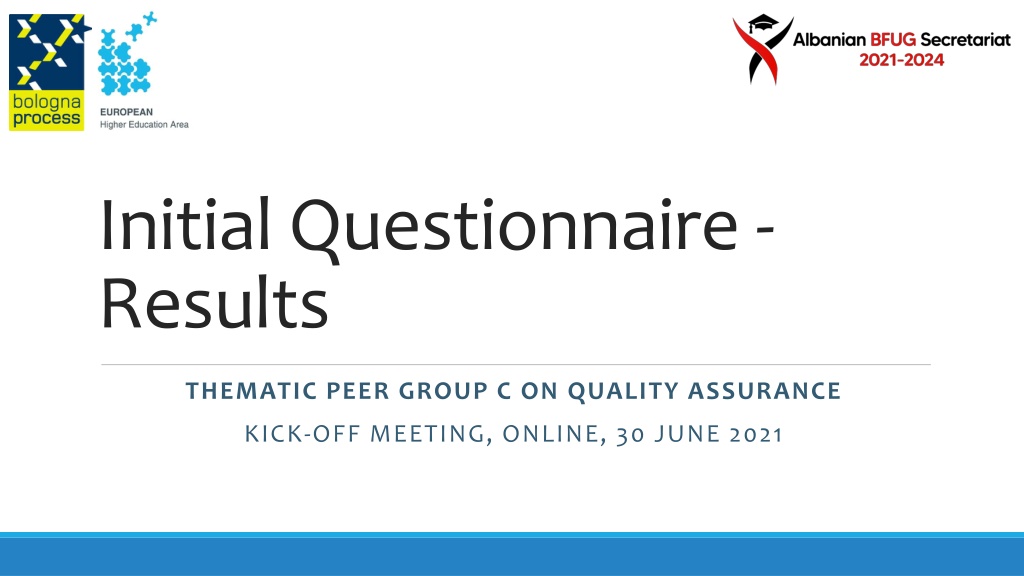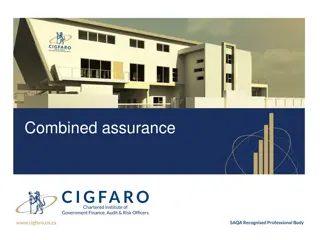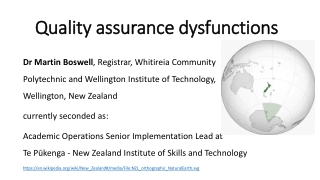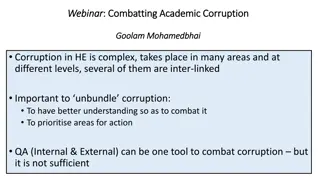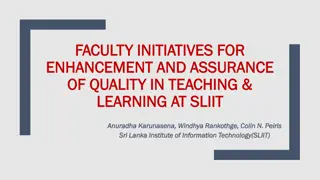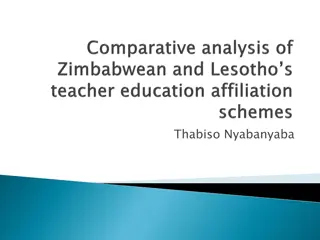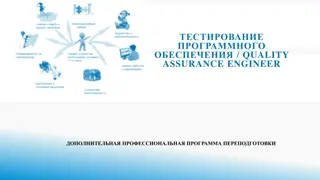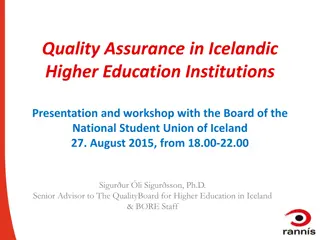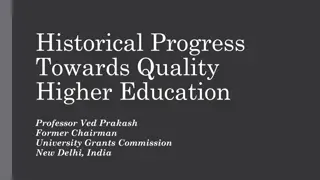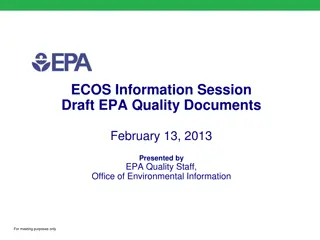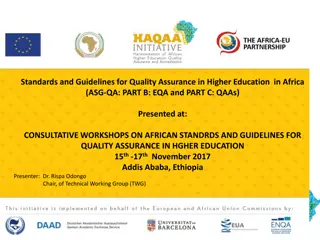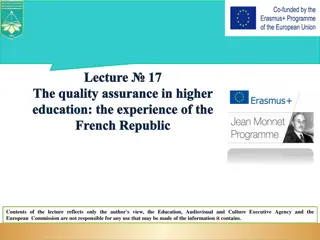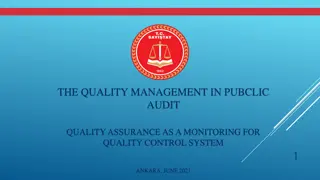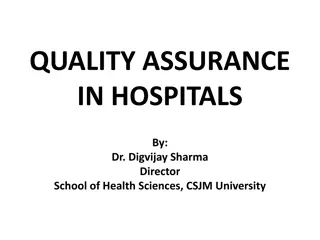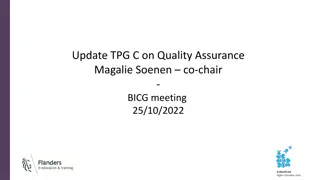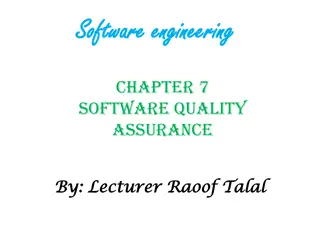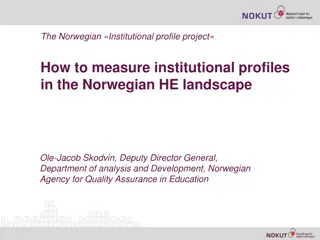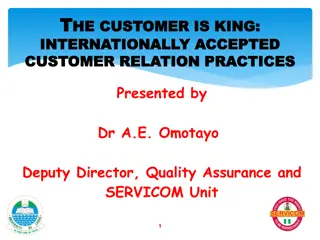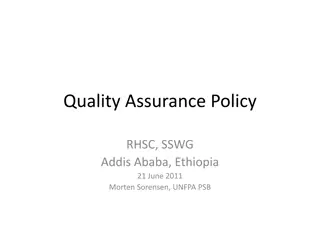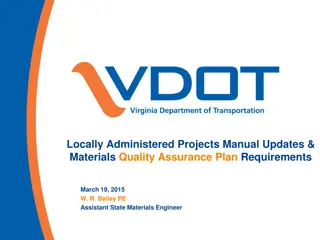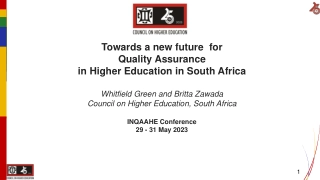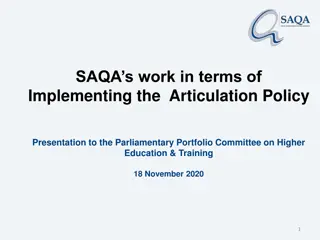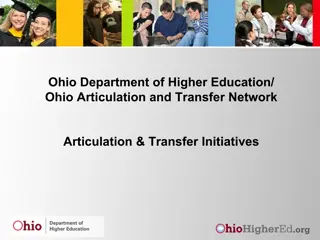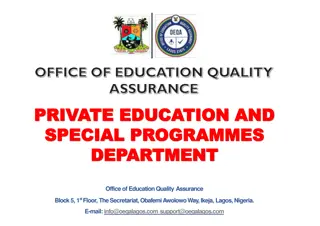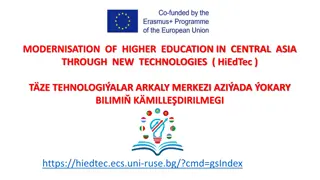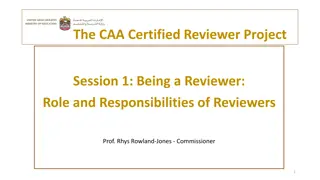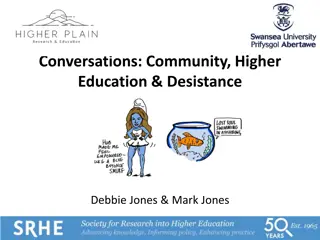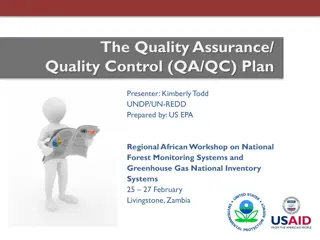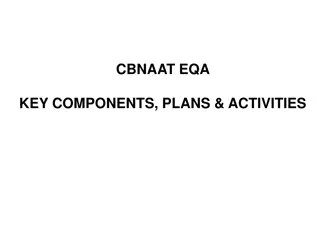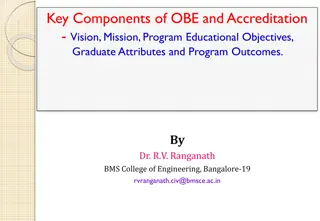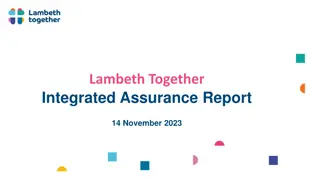Progress and Challenges in Implementing Quality Assurance in Higher Education
The initial questionnaire results and Rome Communiqu? highlight the progress and challenges in aligning quality assurance systems with European standards. Key achievements include guidelines for IQA procedures, building quality culture, and combating academic fraud. Challenges include assessing effectiveness of IQA, digitalization, and enhancing QA procedures at institutional levels.
Download Presentation

Please find below an Image/Link to download the presentation.
The content on the website is provided AS IS for your information and personal use only. It may not be sold, licensed, or shared on other websites without obtaining consent from the author. Download presentation by click this link. If you encounter any issues during the download, it is possible that the publisher has removed the file from their server.
E N D
Presentation Transcript
Initial Questionnaire - Results THEMATIC PEER GROUP C ON QUALITY ASSURANCE KICK-OFF MEETING, ONLINE, 30 JUNE 2021
TPG Composition and answers 47 members 29 answers 40 countries + EC 20 HE authorities 17 QA agencies 3 both 23 countries 6 stakeholders 6 stakeholders
Rome Communiqu We acknowledge the progress made in the development of quality assurance systems aligned with the ESG, and we commit to removing the remaining obstacles, including those related to the cross-border operation of EQAR registered agencies and the application of the European Approach for Quality Assurance of Joint Programmes. We commit to ensuring that our external quality assurance arrangements cover transnational higher education in the EHEA with equal standards as for domestic provision. In view of the need for increased flexibility and openness of learning paths, smaller units of learning and greater synergies among higher education institutions, we encourage an enhancement-oriented use of the ESG to support innovation in higher education and its quality assurance.
Rome Communiqu EQAR registered agencies are allowed to operate 19 Holy See, Slovakia, France, Latvia, Luxembourg, Italy Using the European Approach for Quality Assurance of Joint Programmes 14 Equal standards for transnational higher education 15 Holy See, Czech Republic, Finland, Ireland, Slovakia, France, Sweden, Romania, Malta, Switzerland, Latvia, Cyprus, The Netherlands, Russia, Italy, Austria Measures to support innovation in HE and QA 16 Total answers 23
Implementation of the ESG 2.1 Achievements and challenges Standard Achievements Challenges Challenges / Actions Guidelines and support for HE to develop IQA procedures and institutional strategic planning; identify ways to build the quality culture; sharing knowledge and good practices among HEI and collaboration QA agencies - HEI; simplify standards; how to asses the effectiveness of IQA; combat academic fraud practices; digitalization of procedures; evaluation of online study programmes; encourage HEI towards a self critical approach when conducting QA procedures; moving from programme level to institutional level accreditation; focus on the external audit of the IQA procedures more trust, less control. Czech Republic, Croatia, Slovakia, Romania, Slovenia, Malta, Switzerland, Latvia, The Netherlands, Luxembourg, Russia, Austria 2.1 Consideration of internal quality assurance Holy See, Finland, Ireland, Norway, Belgium FL, Cyprus
Implementation of the ESG 2.2 Achievements and challenges Standard Achievements Challenges Challenges / Actions Improving data management for decision making; taking into consideration the social role of HEIs; engagement of stakeholders, as for example employers; evaluation of private HEI; ex-post evaluation of programmes; analyse how different types of EQA procedures could be correlated and simplified to reduce burden on HEI; assessing learning outcomes implementation and student centeredness; including the perspective of students in MBA type study programmes evaluation; clarify added value of each procedure. Holy See, Germany, Croatia, France, Finland, Sweden, Belgium FL, the Netherlands, Luxembourg, Austria Croatia, Finland, Ireland, Slovakia, Hungary, Romania, Slovenia, Norway, Malta, Switzerland, Latvia, Cyprus 2.2 Designing methodologies fit for purpose
Implementation of the ESG 2.3 Achievements and challenges Standard Achievements Challenges Challenges / Actions Develop procedures with increased impact; follow up procedures; incorporate site visits for study programmes, without increasing the workload of evaluation committees; legislative constraints to the publication of reports; assuring quality of reports and consistency between very diverse types of study programmes, HEI or even in time; how procedures will be conducted in the post-pandemic time, online site visits. Holy See, Czech Republic, Germany, Slovakia, Slovenia, Malta, Latvia, Austria Croatia, Finland, Ireland, Norway, Cyprus, 2.3 Implementing processes
Implementation of the ESG 2.4 Achievements and challenges Standard Achievements Challenges Challenges / Actions Holy See, Finland, Romania, Norway, Latvia, Cyprus, the Netherlands, Luxembourg, Austria Czech Republic, Croatia, Ireland, Slovakia, Hungary, Slovenia, Switzerland. Recruiting and involvement of international experts; increase the effectiveness of students and employers involvement; training and selection of experts; involving foreign students; students versus graduates. 2.4 Peer review experts
Implementation of the ESG 2.5 Achievements and challenges Standard Achievements Challenges Challenges / Actions Germany, Croatia, Finland, Slovenia, Norway, Malta, Austria Support HEI in implementation of recommendations; consistency in interpretation of criteria; simplification and avoid overlapping of criteria between different types of evaluation; criteria imposed by law (administrative) versus quality oriented criteria. Holy See, Czech Republic, Sweden, Latvia 2.5 Criteria for outcomes
Implementation of the ESG 3.1 Achievements and challenges Standard Achievements Challenges Challenges / Actions Holy See, Czech Republic, Croatia, Finland, Ireland, Romania, Norway Avoid review fatigue; renew the relationship with HEI by strengthening autonomy, trust and flexibility; involvement of stakeholders, especially in early stages of different processes, building strategic partnerships with stakeholders. 3.1 Activities, policy and processes for quality assurance Slovenia, Malta, Austria
Implementation of the ESG 3.3 Achievements and challenges Standard Achievements Challenges Challenges / Actions Holy See, Croatia, Finland, Romania, Latvia, Austria Establishing the QA agency as an legal entity; nomination of members in the governing structures or committees (e.g. appeals committee); financial independence. Czech Republic, Slovenia, Norway, Malta, Cyprus 3.3 Independence
Implementation of the ESG 3.4 Achievements and challenges Standard Achievements Challenges Challenges / Actions Germany, Croatia, Finland, Ireland, Hungary, Sweden, Norway, Cyprus, Austria Propose tools and services to support HEI to achieve their mission; risk management; use reports for decision making at national level; secure resources to conduct thematic analyses, without affecting the evaluation activities; relevance of themes; conducting thematic analysis in collaboration of HEI; increase the visibility of these reports. Holy See, Czech Republic, Slovenia, Malta, Belgium FL, Latvia, Luxembourg, Russia 3.4 Thematic analysis
Implementation of the ESG 3.6 Achievements and challenges Standard Achievements Challenges Challenges / Actions Risk management procedures; extending the IQA procedures to all activities of the agency; establish and increase collaboration among departments; increase relevance and efficacity of IQA procedures so they reflect the reality within the QA agency; implementation of the outcomes of the IQA shortcomings identified. 3.6 Internal quality assurance and professional conduct Hungary, Norway, Malta, Switzerland, Austria Czech Republic, Croatia, Finland
Priorities Cross-border QA 23 Enhancement-oriented use of the ESG 19 Internal quality assurance 17 The European Approach for Quality Assurance of Joint Programmes 16 Legislative framework in line with the ESG 14
Priorities - % countries for which activities are included in strategies, action plans Legislative framework in line with the ESG 78% The European Approach for Quality Assurance of Joint Programmes 50% Enhancement-oriented use of the ESG 41% Cross-border QA 38% Internal quality assurance 17%
Priorities - Legislative framework in line with the ESG Differences and commonalities of QA legal framework in MS and among different types of HEI/programmes; Examples and best practices in legislation; Difficulties especially for the design of external QA procedures (ESG 2.2), clear delamination of responsibilities for appeals and complaints (ESG 2.7), the publication of reports (confidentiality of information, conflict between private and public interests, protection of intellectual property) and methodologies (ESG 2.6, ESG 2.3) and the independence of QA agencies (ESG 3.3); QA system not related to accreditation not powerful, but it creates a relationship of collaboration and enhancement with the HEI and the involved stakeholders; Accreditation/quality assurance of joint studies with emphasis on European universities studies; Considering social dimension in higher education / social role of higher education; Eliminate the two-step ex-ante programme evaluation procedure; An effective QA and support system that focuses on content rather than on administrative aspects of quality; Integrating new trends (digitization, innovation, micro credentials) in ensuring effective QA system; For ESG Part 1 and ESG 2.1 the regulated responsibility can not be borne by external QA alone; Internal QA.
Priorities - Enhancement-oriented use of the ESG Define the concept; Specific provisions or standards that could be included in the Methodology and procedures for external QA; Countries who have been using the ESG for many years should see the continued value and use also beyond the minimum standards use; "Agile" quality assurance - internal and external QA should adapt to a dynamic reality and become more open, the use of the digitally supported infrastructure and data-driven processes; Exploring the appropriate balance between, on one hand, HEI autonomy and responsibility for education and research provision, and, on the other hand, the rights and expectations of students on quality of the learning experience and learning outcomes (other stakeholders expectations also relevant); Focus on student-centred learning, teaching and learning (ESG 1.3); Creation of a quality culture and building trust; Support to the institutions in compiling a satisfactory self-assessment report; Set-up a meaningful follow-up system, including examples of good practice.
Priorities - Enhancement-oriented use of the ESG Adjustments in a new version of the ESG; Possible rethinking of the role of QA agencies, and of the modalities of the dialogue between all parties involved in QA; The enhancement use of ESG in correlation with the registration process in EQAR, that shall be designed in order to fit for the purpose; To be used for the QA of European Universities / micro-credentials; To consider the third mission activities; Support academic integrity.
Priorities - Effectiveness of internal quality assurance arrangements, including the use of QA results in the decision-making process and quality culture as well as links to learning and teaching Best practices, specific provisions or standards that could be included in the Methodology and procedures for external QA; Getting a better understanding of what constitutes relevant results in QA; Ensure that IQA processes do not take time from teacher - student interaction; Design support measures for HEI; Enhanced communication; With increasing HEI autonomy, it is crucial that EQA should be designed to capture and support HEI systematic and effective use of IQA results in their strategic governance and decision-making processes, as well as how such results translate into learning and teaching in HEIs study programmes and courses; An effective QA and support system that focuses on content rather than on administrative aspects of quality; Integrating new trends (digitalization, innovation, micro-credentials, data management) in ensuring effective QA system; Involvement of students in IQA processes, including programme design; Evaluation of the functioning and effectiveness of IQA processes beyond their formal design; Translation of IQA arrangements into daily operations of HEIs and quality culture.
Priorities Cross-border QA Making the concept better known; Providing support for implementation; Examples of good practices, for example the European Universities alliances; Clarify the connection between results of cross-border QA and recognition of qualifications with emphasis on possibility of automatic recognition; Convergence of EHEA measures (standards, regulations etc.) to cover cross-border provisions (outgoing perspective); QA of international providers; Ensuring that the offer to international students under transnational education (TNE) is comparable to that of home students but also addresses the specific needs of such students; QA of European universities alliances, micro-credentials, distance education/online learning; Support for internationalization; Speed-up and simplify automatic recognition of external QA procedures and results made by EQAR-registered entities anywhere in Europe; Establish the right balance between international standards and national frameworks.
Priorities The European Approach for Quality Assurance of Joint Programmes Making the concept better known; Providing support for implementation; Examples of good practices, for example the European Universities alliances; The exclusive use of the European Approach guidelines during an EQA procedure without any added criteria regarding national regulations and issues related to calendar mismatch with national priorities; Support for internationalization; Extend the analysis to the possibility to establish joint programmes taking into consideration the national context.
Priorities Other topics Thematic analyses; Adaptation of QA tools to micro-credentials, European Universities Alliances, LLL; QA of research/PhD programmes; Use of experts reports: reports addressed exclusively to the assessed HEI with potential and impact is maximized, whereas a shorter "user friendly" version shall be published, still guaranteeing transparency on the outcomes and recommendations for quality enhancement; Emphasizing the importance of developing/improving the social role of HEIs and the social role of QA agencies; The connection between good working conditions for academic staff, including more permanent positions, and creating a quality culture; The importance of a strong link between teaching and research for quality education.
Priorities preliminary conclusions Good practices Legal framework Research Concept Online education Support in implementation Digitalization Consistency Impact Social role Internationalization European Universities Cross-border QA Joint programmes TNE Simplification Relevance Quality culture Micro-credentials Trust Stakeholders
Priorities Planned projects Support the work of TPG C - organization of approx. 2 international meetings/year; PLA; staff mobilities; activities on subgroups, who will target activities and tools related to specific topics, e.g. European Universities and micro-credentials (Flanders (co chair), Romania (co chair) , EQAR, ENQA (TBC)) Use of the ESG and the future of quality assurance in Europe ( E4+) Project for countries where the ESG have not yet been implemented for external QA (ENQA+ QA agencies, governments) Bologna With Stakeholder Eyes - continuation. Gathering student perspectives on the developments on Bologna process (also on the QA as a sub activities and sub chapter) (ESU+) Work based learning, recognition of prior learning and micro-credentials, short cycle (EURASHE)
4 countries / organizations no preference (coordinator/partner) Priorities Potential projects TOPICS (Country/ Organization) Improving data management and data sharing for better QA (on national and international level) / Digitalisation of teaching and learning (incl. distance learning, e-learning, hybrid learning) / Digitalization Stakeholders involvement / Student Participation in QA Micro-credentials and short learning courses and quality assurance systems / Cross-boarder quality assurance of micro- credentials or other sub-degree qualifications Quality culture / Internal quality assurance of HEIs) QA of the European Universities / European universities / QA of European Universities alliances / Cross-boarder quality assurance, esp. in relation to EU consortia; alliances / Simplifying and under regulating QA in Europe as an important step for more cooperation within Europe / Cross-border quality assurance / European Approach for Quality Assurance of Joint Programmes / ESGs & European Approach: state-of-play & reflections on possible revision Academic integrity Sustainability in HE and QA Measuring the impact of external quality assurance Enhancing the quality of student QA pools, training of student experts Croatia, Sweden, EURASHE Slovakia, ESU Slovakia, Sweden, Croatia, EURASHE, Austria Romania, Germany, Latvia Finland, Ireland, Sweden, Switzerland, Croatia, EQAR, Slovakia, Germany, France, Latvia, Russia, Italy, Austria Ireland Ireland Norway ESU France, EQAR, ENQA, Cyprus EURASHE Croatia, Cyprus Norway, ESU QA in the EHEA/ / Implementation of the EHEA key commitment on QA Quality work based learning Qualification frameworks and QA / Recognition Exploring and defining new pathways in future quality assurance / Innovative methodology How to adapt QA to the various missions of HEIs (including research and societal aspects) / Qa of third mission / QA of PhD programmes France, Italy
